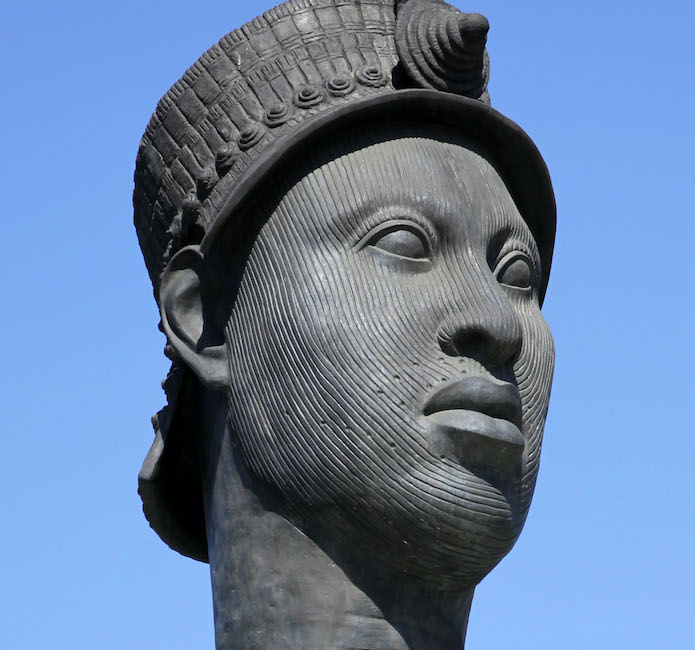At first they were called ‘mocambo’: a word from the Mbundu of what is now Angola meaning ‘hideout’. They were communities of escaped slaves that began springing up in colonial Brazil in the 17th-century. Typically they might contain around fifty people, predominantly men. No less typically, the colonial powers – either the Dutch or the Portuguese – destroyed them within a year or two.
But Palmares was different. Founded around 1605, in dense forest between mountains in the north-eastern province of Pernambuco, it survived until 1694, an enclave of African civilisation in the South American jungle. At its peak, it covered nearly 10,000 square miles. Estimates for its population range as high as 30,000. It contained at least ten well-fortified settlements. In its later decades, native-born inhabitants outnumbered former slaves. They called each other ‘malungo’ – comrade. Escaped slaves would always find freedom in Palmares; captured slaves had to redeem themselves by seizing a fellow slave in a raid, a kind of pyramid scheme of resistance.
A Dutch expedition of 1645 to Palmares noted “well-kept farmlands, all kinds of cereals, beautifully irrigated with streamlets”. Nonetheless, the settlements were well fortified, protected by walls, palisades and networks of traps; the largest settlement, the royal enclave of Macoco, built around a seemingly impregnable precipice, was surrounded by spikes in the ground – at foot level, at thigh level at throat level. There were hidden pits full of spikes too. Perhaps it is relevant that after Palmares another word for these enclaves began to be used: ’quilombo’, again from the Mbundu. It meant ‘war-camp’.
The quilombo was ruled by Ganga Zumba – ‘ganga’ means ‘lord’ – and his family. Relations with the colonials were complicated. It is said – by the Portuguese – that one of their main activities was raiding colonial estates to rob the settlers of their slaves. Some plantation owners sent small private armies against Palmares, both as reprisalsand to steal slaves back. But other colonials sold them guns and ammunition, paid for by gold and silver from their raids. Merchants traded tools for food with them.
There were eight military expeditions against Palmares between 1672 and 1680, each unsuccessful. “The Negroes of Palmares… seem invincible,” some Portuguese plantation owners reported.
Every time there was a new governor of Pernambuco, which was often, Ganga Zumba offered a peace treaty. One was actually signed, in June 1678, but whether either side was in good faith is questionable. Zumba had “no other desires but to trade… to have a treaty, to serve his Highness in whatever capacity”, he said.
If the Portuguese ever felt bound by the treaty, which is doubtful, they certainly did not after Zumba was deposed a year or so later in a palace coup and succeeded by his nephew, Zambi. Six more expeditions followed between 1680 and 1686.
Eventually the Portuguese called in a new force of ‘bandeirantes’ from Sao Paolo, hardened Portuguese-Amerindian soldiers, skilled in jungle warfare. They fought under Domingos Jorge Velho, who described the approaches to Palmares as “the roughest road [through] the most inhospitable and hunger-ridden wilderness in the world”.
In two years of fighting, they reduced Palmares to a single stronghold: Macoco. Then they laid siege to it. The siege lasted 42 days. On the night of 5 February 1694, the remaining people of Palmares attempted to break through the Portuguese lines. In the darkness, some 200 of them, it is said, fell “from a rock so high that they were broken to pieces” by the fall. Or did they leap? Some 200 more died in hand to hand combat. Over 500 were captured and sold.
Zambi, one of the last to leave the citadel was shot twice and taken alive. It took the Portuguese three years to hunt down the thousands who had fled into the jungle. In the meantime, they took no chances. Zambi was beheaded on 20 November 1695.
The memory of what had been – and what was lost – lingered. There are records of escaped slaves still fleeing to the site as late as 1746, in search of somewhere that was, and for a long time, home.
This is an extended version of a piece that first appeared in the November 2023 issue of History Today.
Like this? You can read more of Mathew’s History Today Months Past pieces here.

Leave a comment